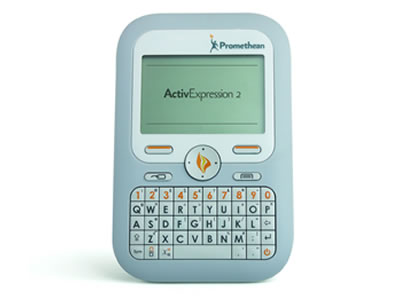
Student response system (SRS) technology has caught on in classrooms nationwide as a tool for boosting class participation, as well as helping teachers ensure that students understand what’s being taught before they move on to another concept. But the current generation of the technology has its limitations.
For one thing, the lag time between student responses kills the pace of learning, says Promethean Director Tony Cann. In a typical use of the technology, the teacher poses a question to the entire class, then pauses as students answer the question on their personal “clicker” devices. This results in a lot of waiting around—time that could be put to better use.
Another problem is that students see, and answer, the same question as their peers. For students who already understand the material and are ready to move on, this can be a tedious process—and teachers risk losing their interest.
Promethean thinks it has developed a solution to these problems. The company has unveiled a brand-new version of software that could take SRS technology to a whole new level—something the company calls “real-time personalized intervention” (RTPI).
The new technology can send a question directly to each student’s ActivExpression unit—Promethean’s version of a “clicker” device. Once the student answers a question, he or she immediately gets a new question to answer. Best of all, the system is adaptive, meaning it can quickly hone in on each student’s abilities and deliver personalized questions that target these abilities.
“If you believe interactive whiteboards are a level 4 improvement [in education], this is a level 8,” Cann said, adding: “It will have an enormous effect on teaching and learning.”
Cann said the technology gives teachers the ability to do handheld formative assessment in real time—assessment that adapts to the pace of each student, while also filling the time for each student. Students receive immediate feedback on their responses, and teachers can see how the entire class is progressing on their own computer screen.
In the teacher’s view, each student response is color-coded according to the question’s degree of difficulty. Wrong answers have a red “X” next to them, so teachers easily can see which students are progressing quickly through the questions and which need more help. The teacher then can work individually with students as they need it.
Ron Clark, founder of the Ron Clark School in Atlanta, called the development “shockingly effective, exciting, and brilliant.”
“As a teacher, I am able to send questions to each student’s ActivExpression, and they are able to work on the problems at their own pace. I can instantly track the progress of each student on the ActivBoard, and I can go directly to the students who aren’t on task or who are having problems,” he said.
“The best part about RTPI is that it places a sparkle on every student’s face. They love the thrill of texting their answers, and the competitive component of seeing how quickly you can answer all of the questions in each series is something that appeals to kids a great
deal.”
After class, Clark said, “I always review the responses again to see where there are overall weaknesses in the class. I also take note of material that the students understand fully, and I realize that there is no need to review the content that has been mastered.”
Cann said the system is capable of delivering 15,000 to 20,000 self-paced questions per minute. It is available as a free software upgrade for current ActivExpression users, and the ActivExpression units themselves—which turn on in just two seconds and have a battery life that lasts for about 25,000 questions, he said—work with any whiteboard system, not just the ActivBoard.
Links:
- Demco Acquires StickTogether, Accelerating StickTogether’s Mission and Expanding Demco’s Range of Innovative Solutions - April 16, 2024
- EPS Learning Programs Selected by Virginia Board of Education as Recommended Literacy Solutions - April 15, 2024
- Vernier Science Education Selects 10 Inspiring STEM Teachers to Join Its New Vernier Trendsetters Community - April 12, 2024


Comments are closed.